How to keep your animal’s water trough clean with no chemicals. This easy to setup trough for our goats stays crystal clear!
When we first brought our goats home, I used small buckets for them that I filled every day. The previous owners of our house had left a water trough though and I was interested in using it as an alternative to daily bucket feeding. My main concern was cleanliness. I didn’t want to need to empty it daily, worry about mosquitoes breeding in it, or problems with our goats’ health.
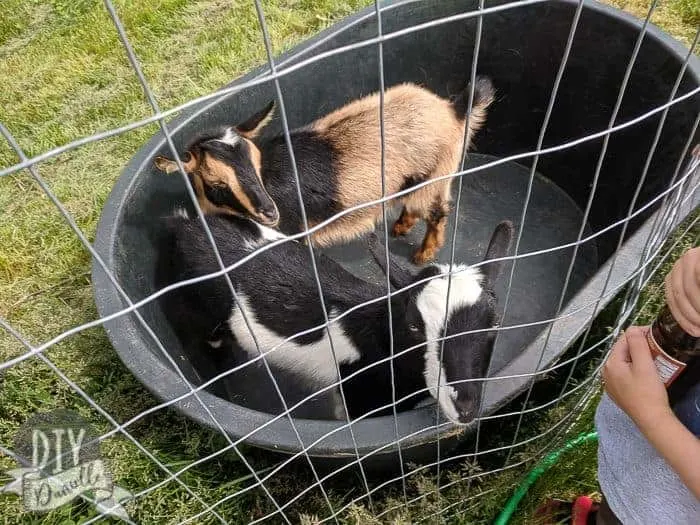
Many people swore by keeping a few goldfish in their water tanks to keep the algae and mosquito larvae down. I decided to get a bit more fancy than that- I knew from having our pond at the last house that fish produce waste so clear water isn’t necessarily a good indication of the cleanliness of the water. I knew that having a good ecosystem is the best way to keep a fish tank or pond clean so I decided to apply the same concept to the water trough.
This is a LARGE trough… here’s a picture with my Nigerian Dwarf goats beside it for comparison (ps. here’s a tutorial on a rolling hay feeder for the goats!).
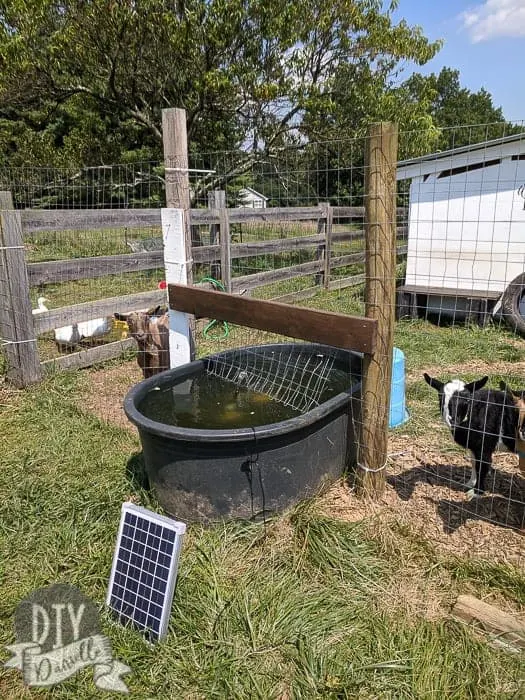
This original setup worked okay, but I’m going to talk about different elements and what I’ve founds works best for us. This will be long so bear with me.
This post may contain affiliate links which may earn me commissions should you click through them and take certain actions. As an affiliate for Amazon, Cricut, xTool, Home Depot, and other sites, I earn from qualifying purchases. Please DIY carefully. View my full legal disclosures here.
Please read the whole post so you don’t miss any important information!
Table of contents
I believe the trough pictured is somewhere between 100-150 gallons. You can check out stock tanks on Amazon, but Ace Hardware is possibly a better option if you want to avoid shipping costs and do local pickup. Make sure it has a drain. I like the Rubbermaid tanks, which come in 50 gallon, 100 gallon, and 300 gallon sizes.
Common Issues with Keeping a Trough Clean
There are a few common issues that farmers have when keeping a trough clean. First, animals do crazy things like poo in their trough. It happens. There’s no fix for that besides cleaning and discouraging the behavior.
For other issues, though, there are some fixes and considerations.
- Algae Growth: Algae will grow in a trough over time without cleaning. It’s easy to remove and clean, but is a particularly large issue when the trough is in full sunlight.
- Debris: Debris such as leaves and hay can fall into the trough, causing the water to get dirty faster.
- Water Freezing: This is less of a cleanliness issue, but it’s still an issue. And the solution impacts cleanliness. I found that my trough with a heater in it has far faster algae growth than my trough that does not. But the fish didn’t survive as well in the trough with the heater.
- Too much trough, too few animals: Our trough wasn’t getting a lot of use when I only had the three goats using it. The water was sitting for too long in the trough, unused, and refilling meant emptying the whole thing out. The best bet is to have an appropriate sized trough for your animals; it’s easy to clean when they naturally drain it over a short period of time. We combined our trough to be used in two fields so the horse, goats, and sheep all have access to it. This allows it to drain faster.
How to Keep Water Troughs from Going Green
When you see green in the water and along the sides of the water trough, you’re seeing algae growth. Algae is a plant; it needs light to grow. Sunlight and warmth increase growth, and nutrients from decaying plants and other organic matter (ie. leaves falling in the trough) help feed the algae. So you’re battling those factors.
You can decrease algae growth by adding goldfish to eat the algae, by decreasing how much sunlight hits your trough (particularly in the summer), and by decreasing how much debris enters your water.
The other option is to add plants to your trough; the caveat being that the plants either must be non toxic to your animals or be inaccessible to the animals (ie. bottom dwelling plants under some type of cover). Algae is a plant and needs some of the same things to grow as plants so essentially other plants can suck up the nutrients the algae needed to grow. Plants that float on top of the trough water can provide shade to block the light. However, dead plants can cause algae plants during their decaying process.
To reduce the chances of mosquitos, you can add water circulation to your water.
I’ve found that adding plants, fish, shade, etc. can help prevent algae, but you need to be conscious of if certain options complicate cleaning. For example, plants and fish make it quite a bit more difficult to empty the whole trough. They can also make it difficult to add a heater through the winter. The trade off is that, if properly maintained, you should need to clean the water less.
One struggle we ran into with our troughs was that we had about twenty ducks on our farm that would hop in to bathe in the trough. This dirtied the water, requiring many more water changes than I wanted, and increased algae growth. We sold most of the ducks at the end of last year so the two remaining ducks shouldn’t be a huge burden on the trough system… plus, they seem to be happy in their own duck water buckets now that there’s not as much competition.
Now I’ll explain my original setup and some things I’ve tried with my troughs.
Did you know I have a store with all sorts of fun digital products? Here’s a few you might be interested in, or keep scrolling for the tutorial!
Fish: Do Goldfish Eat Algae?
We have a local fish store that I ADORE called Lilypons in Frederick. I took the kids there to pick up three fish. You DO NOT want koi. You want a type of goldfish that will stay on the smaller side. You also do not want too many fish.
Like having an aquarium indoors or filling a pond with fish, the water trough will not stay in balance with too many fish for the size of the trough. I should have done better math to figure out how many fish to add, but three seems to be working fine for our large trough.
Do NOT place fish in a small bucket or small trough. They need to be able to hide and the water can’t get too hot/cold/freeze. This trough is deep enough that the bottom shouldn’t freeze during the winter.
Our fish are a bit photo shy, but my toddler is watching one of the orange goldfish here.
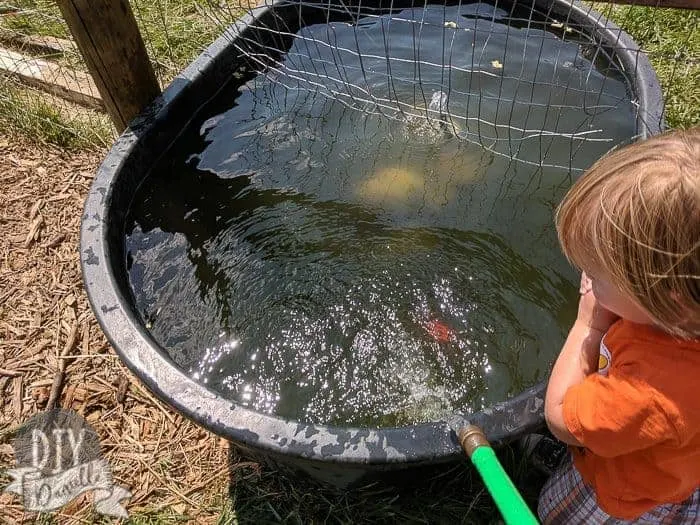
Many farmers swear by adding fish to their troughs. I’m somewhat skeptical because fish produce waste too that can impact algae growth. I found that the fish made it more difficult to add a heater in the winter (we had to empty the trough to install the heater); some of our fish died within 24 hours of the addition, despite how slow the water was to warm up (this should have given them time to adjust).
Filtration: Is it necessary?
I didn’t want to invest in an expensive filter and I didn’t think it would be necessary. Nature provides natural filtration when the ecosystem is in balance. With enough of the correct pond plants, it made sense that the water would be filtered naturally. Here’s a list of pond plants that can provide filtration when there’s enough of them for the size of your trough.
Initially I added water lettuce, but it didn’t survive (my fault, I kept it in a bucket for a while before setting up the trough properly). I decided to replace it with duck weed because that was what I originally meant to buy… but forgot the name of when I was at the store. Whoops.
Duck weed can help the water quality, but can also function as food for livestock. It’s fast growing. The fish can eat it. Overall there are a lot of benefits to duck weed. I love the idea of growing food for the ducks to eat.
I ordered 500 Lemna Minor duck weed plants on Amazon in hopes they would work well. My main issue was that they were tiny and when I let the water over flow, I lost the duck weed pretty quickly. Too many ducks and other critters accessing the water and no chance for the duck weed to catch up repopulating.
You could also try these barley straw bales for filtration as well.
Water Movement
The main priority to avoid mosquito larvae is to make sure there is a lot of movement in the water. They prefer to lay their eggs in still water. I opted for a cheap solar pump that would circulate the water during the day.
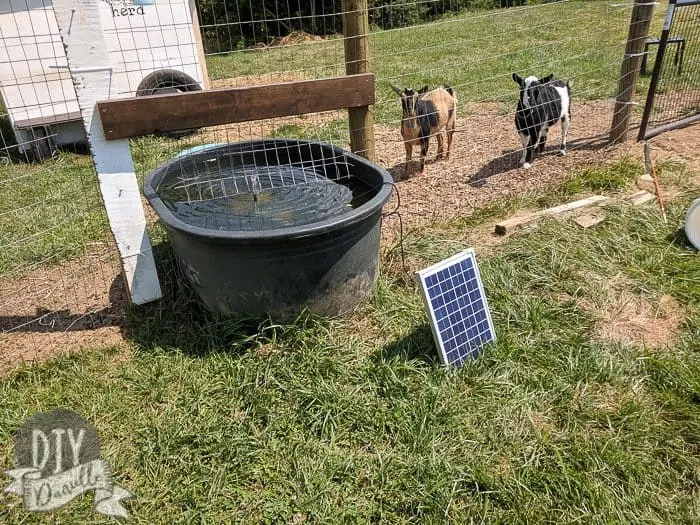
Because the goats chewed the wire, I ended up moving the trough so half of it was outside of their fencing. This allowed me to place the solar pump on the outside of the goat pen. My husband fixed the wires for me.
The pump circulates the water all day, although it’s off at night. It produces a nice pond gurgle all day. When it’s cloudy, the power is off/lower. You could also try one of these wireless pumps that floats on top of the water if your critters aren’t prone to eating or playing with the thing.
The other benefit to the pump circulating water is that it should help prevent the water from freezing in the winter, assuming the pump can function in the cold weather.
Bottom Dwelling Plants
In a natural pond, you’d have plants along the bottom as well. This gives the fish a place to hide. I purchased six or so Anacharis plants and sunk them to the bottom of the trough. The plant helps removes nitrates from the water and “starve” the algae so that it can’t grow/take over. Nitrates are caused by waste in the water… I assume the goat use of the trough will introduce some waste products to the water, but there’s also waste from the fish, bugs and debris that falls into the pond.
Cleaning the Trough
Scrubbing Algae
I purchased a cheap toilet brush over at the Dollar Tree and hung it on a hook on a post by the trough and duck water. If needed, I can scrub the sides of the trough down. I eventually ended up replacing this with a silicone toilet brush because the cheap one had bristles coming off in my water. I’m hoping the silicone will be more durable.
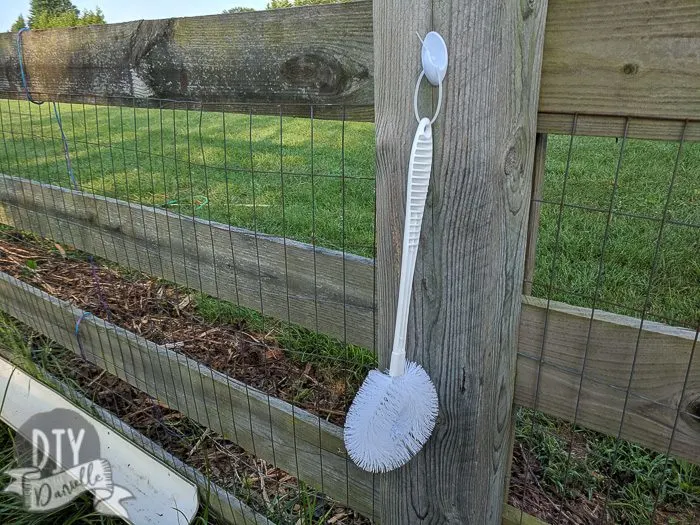
If I’m doing a full cleaning and I don’t have fish/plants in the water, I will use a soap for the inside of the trough. Blue Dawn is my favorite option for cleaning. Just make sure to completely rinse the soap out.
Winter Cleaning
Once I started using a heater that hooked up through my trough drain, emptying the water from the trough via the drain became impossible. The heating element gets really hot so you need to plan to uninstall everything and make sure it’s cool. Unfortunately the heater seemed to increase algae growth so I was looking at emptying every few weeks. I like a nice clear trough so I tend to be fairly proactive about cleaning.
I wait for nice day (above freezing) to empty and clean my trough. Originally, I would scoop out buckets of water manually until it was empty enough to flip and drain. It was a huge project and heavy work. I also don’t like getting wet in the cold.
My husband pointed out that I had a siphon kit that would work perfectly. It does a great job and I can direct the water away from the wet zones, preventing a ton of mud and ice around the trough. It connect to your hose; you turn the hose on and the water pressure helps kick start the siphoning. There’s a green piece you push in and the hose will switch over to pumping fresh water back into the trough instead of emptying the trough. It’s fairly convenient. It allows me to be a bit more hands off for cleaning my trough so I can do other chores at the same time. I usually just stop by and scrub it with my silicone brush.
Here’s a video on how it works:
You could probably do this with one of these less expensive suction siphons too.
Regular Cleaning
For regular trough cleaning, you can simply empty the trough using the drain plug on the bottom. I highly recommend buying a trough with a drain plug that works well and is easy to take off.
Some people attach a hose to their drain plug to help divert the water away from their watering area. You could also attach an on/off valve and add a PVC pipe; when you want to empty the trough, you just open the valve and let it drain through the PVC pipe. I set up my trough like this for drainage this Spring.
Letting It Dry
If you have the option, it’s nice to let your empty water buckets or trough sit to dry in the hot sun for a while. This helps sanitize the trough and kill algae as well. It’s one of my favorite methods of “cleaning,” seeing as it’s hands off.
Shade
While I haven’t added this feature yet, my plan is to eventually add shade over the trough to keep the water cooler in the summer. I think a permanent shade structure could help prevent a lot of issues, particularly if you rigged something with a removable cover. The top could come off in the winter so the sun could still warm the water.
Eventually my plan is to add a cover for both the hay and the water zones, preferably in separate areas so hay doesn’t float into the water trough.
Keeping Your Trough from Freezing
Keeping your trough from freezing is a pretty big deal if you live somewhere that gets cold. We’ve tried a couple of options.
First, I tried using milk jugs full of salt water. I think I needed far more jugs that I had, and it didn’t work great, but it’s a decent thing to try if you don’t have access to electric.
I installed a heater in my trough and that helped keep the water from freezing MUCH better. Unfortunately, it also seemed to negatively affect my goldfish and possible caused fatalities.
When purchasing a heater, check the box carefully for instructions. Some heaters were only made to work with certain brands of trough.
Trough Setup For Two Fields
Initially, I had our trough situated for the goats so half was on the opposite side of the fence. There was a post on either side with a board across. I had wire fencing across the top, but cut the bottom out so the trough could slide in. I tried to bend any sharp pieces of fencing away from the goats and towards the outside of the pen. This is what it looked like…
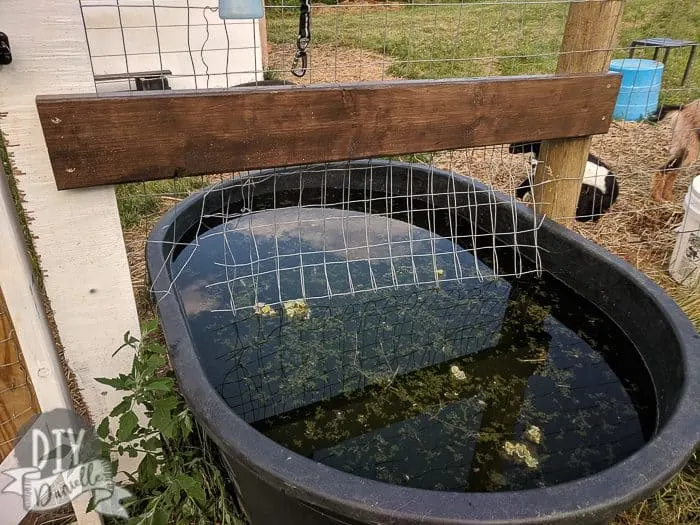
When we added a horse field and had two fields to deal with, I decided to situate the trough between the two fields. This allows me to heat one trough instead of two.
This is how we set it up. The white and black run in shed has a “stall” with a closed door. I use that as a feed and tack room. I will talk more about this dual field feed/water setup in another blog post, but as you can see on the right, my trough is on both sides of the fence.
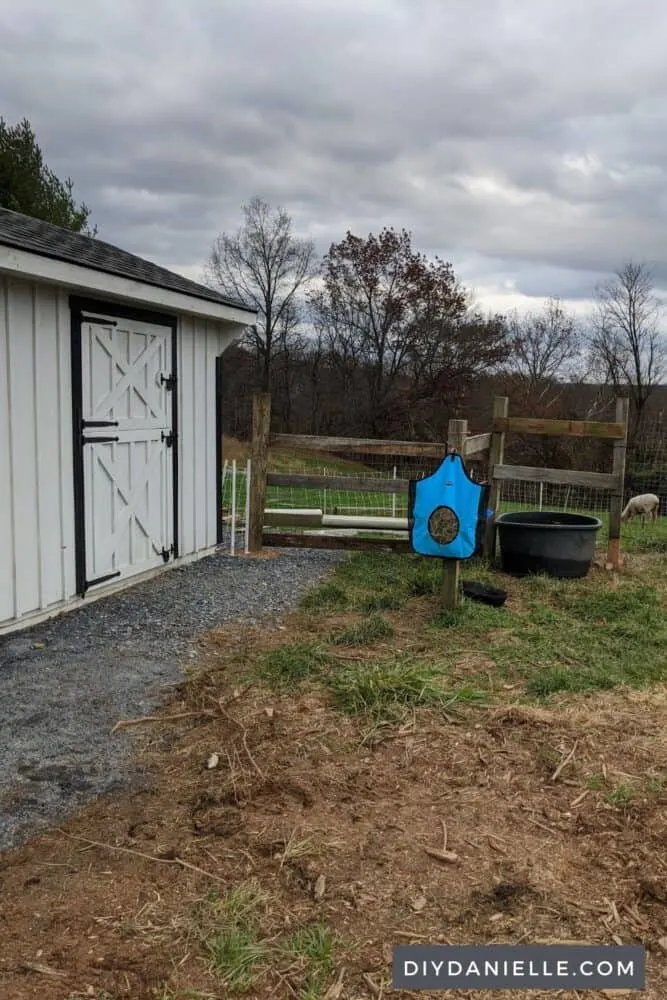
This gives access to the water to two different fields. The goats have a little block to step on to reach the water if needed on the other side.
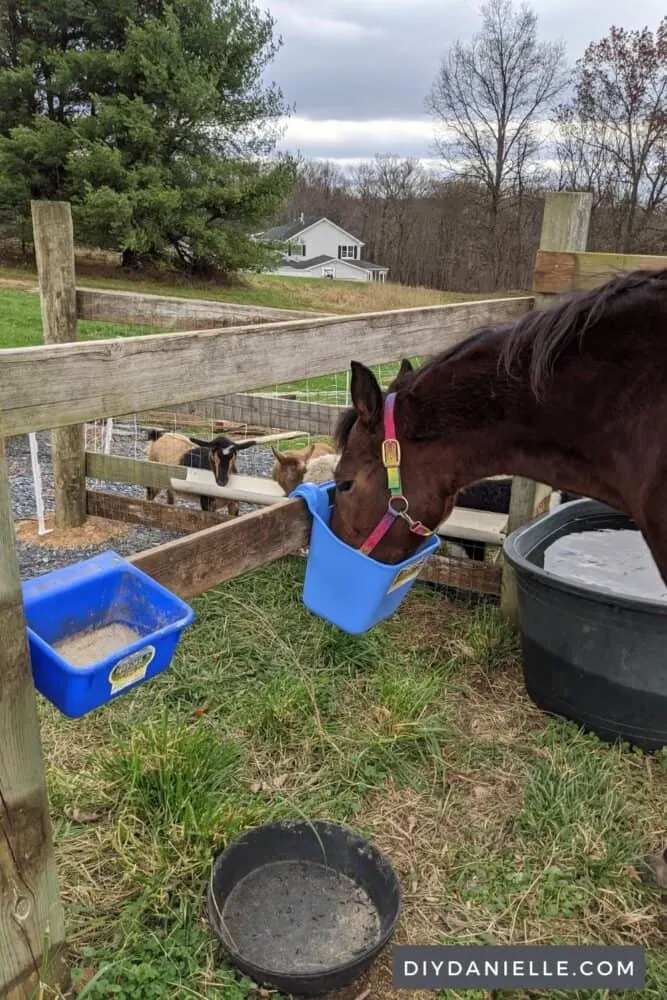
The grass has since worn down and it’s a bit muddy over here, but I am careful with how I drain water so it doesn’t get too bad. If this was my permanent spot for the water, I’d add better footing and drainage here. This is a fairly temporary setup though.
Love creative homestead ideas? Check out these posts too: DIY Duck House | Goat Barn Accessories | Framing the Goat Barn | Siding & Roofing for the Goat Barn | Easy Solar Lighting for a Shed or Barn | Beginner’s Guide to Milking Goats | No Mess Duck Waterer
Hope this helps you work smarter, not harder! Please share and pin this post!
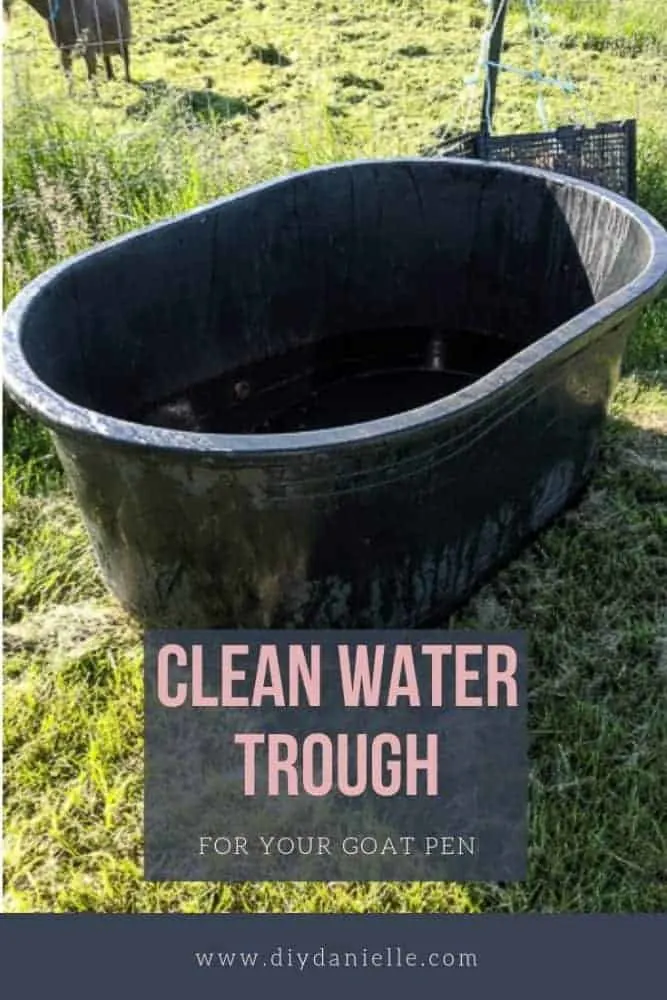
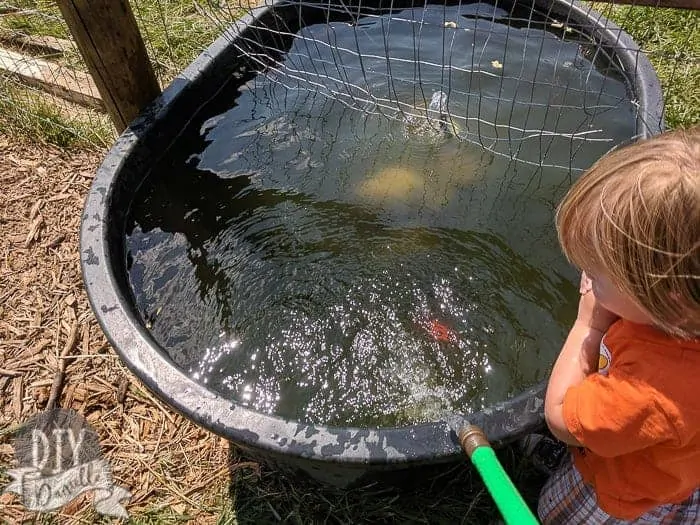
How To Keep A Water Trough Clean
See how easy it is to keep your animal's water trough clean with this simple setup. Plus it uses no chemicals.
Materials
- Trough with drain
- Small gold fish
- Pond Plants
- Toilet Brush
Tools
- Water Pump
Instructions
- Fill the trough with water.
- Place half the trough inside the goat pen and half out.
- Add pond plants.
- Install water pump.
- Add gold fish.
- Clean the trough with a toilet brush.
Recommended Products
As an Amazon Associate and member of other affiliate programs, I earn from qualifying purchases.
Google Web Story: Tips for Keeping Your Trough Water Clean!

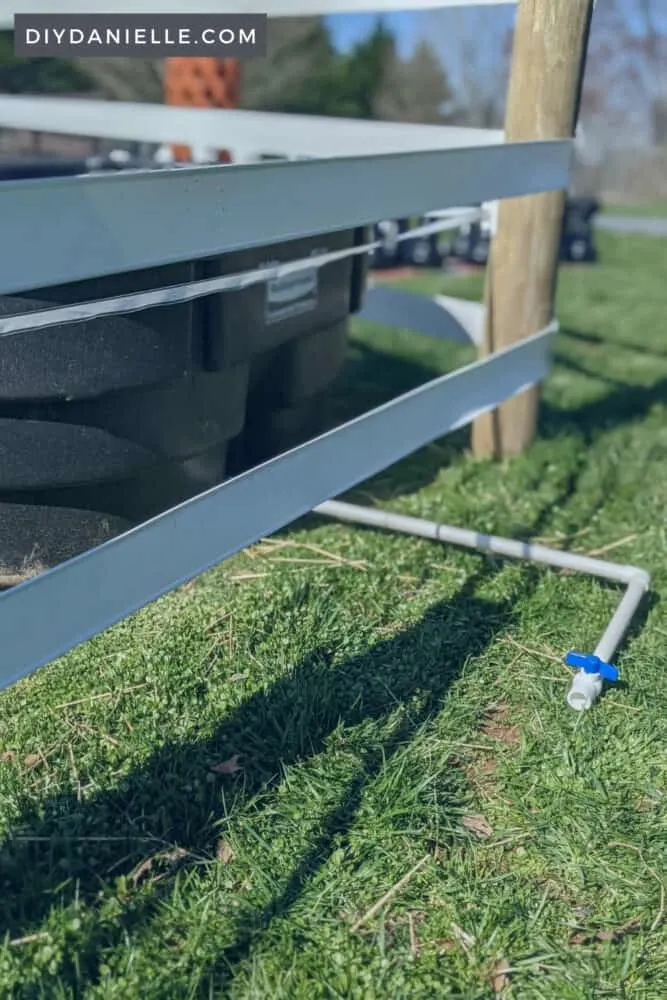




Jessi
Friday 16th of September 2022
Great info. I have a few tanks I’ve experimented with and have one that has been clear now for a couple of years. The biggest challenge is having to have them in full sun. I have fish, plenty of broken pots and things in the bottom as a habitat. Floating plants and plants in terra cotta pots with the top couple of inches above water. They help filter and help keep the water cooler and with less algae from their shade. It also has a pump to keep water moving slowly. It’s self contained now. The fish eat bugs and algae. The plants clean up the poop. It has a layer of settlement at the bottom but that can serve to plant bottom dwelling plants now I wish I could figure out plants my animals won’t eat so I can set up my pasture tanks too.
If you can’t do plants even just some fish really do help though